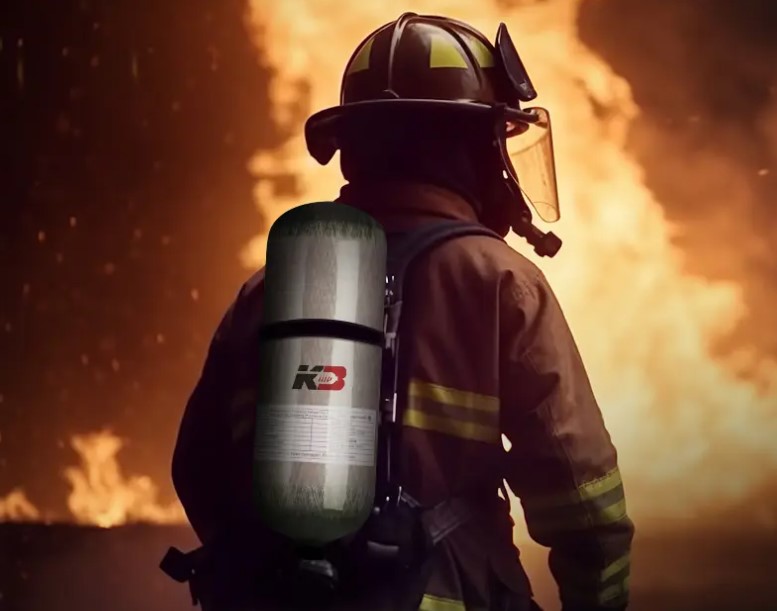In the realm of high-pressure gas storage, carbon fiber cylinders represent the pinnacle of innovation, blending unparalleled strength with remarkable lightness. Among these, Type 3 and Type 4 cylinders have emerged as industry standards, each with distinct characteristics and advantages. This article delves into these differences, the unique benefits of Type 4 cylinders, their variations, and the future direction of cylinder manufacturing, particularly for Self-Contained Breathing Apparatus (SCBA) assemblies. Additionally, it offers guidance for users considering carbon fiber cylinder products, addressing prevalent questions within the SCBA and carbon fiber cylinders industry.
Type 3 vs. Type 4 Carbon Fiber Cylinders: Understanding the Difference
Type 3 cylinders boast an aluminum liner completely encased in carbon fiber. This combination offers a robust structure where the aluminum liner ensures gas impermeability, and the carbon fiber wrap contributes to strength and reduced weight. Though lighter than steel cylinders, Type 3 cylinders maintain a slight weight disadvantage compared to Type 4 due to their metal liner.
Type 4 cylinders, on the other hand, feature a non-metallic liner (such as HDPE, PET, etc) fully wrapped in carbon fiber, eliminating the heavier metal liner found in Type 3 cylinders. This design significantly reduces the cylinder’s weight, making Type 4 the lightest option available. The absence of a metal liner and the utilization of advanced composites in Type 4 cylinders underscore their advantage in applications where weight reduction is crucial.
The Advantage of Type 4 Cylinders
The primary advantage of Type 4 cylinders lies in their weight. Being the lightest among high-pressure gas storage solutions, they offer substantial benefits in portability and ease of use, particularly in SCBA applications where every ounce matters to the user’s mobility and stamina.
Variations within Type 4 Cylinders
Type 4 carbon fiber cylinders can feature different types of non-metallic liners, such as High-Density Polyethylene (HDPE) and Polyethylene Terephthalate (PET). Each liner material offers unique characteristics that affect the cylinder’s performance, durability, and application suitability.
HDPE vs. PET Liners in Type 4 Cylinders:
HDPE Liners: HDPE is a thermoplastic polymer known for its high strength-to-density ratio, making it an excellent choice for resisting impacts and withstanding high pressures. Cylinders with HDPE liners are characterized by their robustness, flexibility, and resistance to chemicals and corrosion, making them suitable for a wide range of gases and environments. However, HDPE’s gas permeability might be higher compared to PET, which could be a consideration depending on the gas type and storage requirements.
PET Liners: PET is another type of thermoplastic polymer, but with a higher stiffness and lower permeability to gases compared to HDPE. Cylinders with PET liners are well-suited for applications requiring a higher barrier to gas diffusion, such as carbon dioxide or oxygen storage. PET’s excellent clarity and good chemical resistance make it a viable choice for a variety of applications, although it might be less impact-resistant than HDPE under certain conditions.
Service Life for Type 4 Cylinders:
The service life of Type 4 cylinders can vary based on the manufacturer’s design, materials used, and the specific application. Generally, Type 4 cylinders are designed for a service life ranging from 15 to 30 years or NLL (No-Limited Life span), with periodic testing and inspection required to ensure their safety and integrity throughout their use. The exact service life is often determined by regulatory standards and the manufacturer’s testing and certification processes.
Future Trends in Cylinder Manufacturing and SCBA Assemblies
The future of cylinder manufacturing is poised for further innovation, with trends leaning towards even lighter, stronger, and more durable materials. Advancements in composite technology and non-metallic liners are likely to drive the development of new cylinder types that could offer even greater advantages than current Type 4 models. For SCBA assemblies, the focus will likely be on integrating smart technologies for monitoring air supply, improving user safety, and enhancing the overall efficiency of SCBA units.
Choosing the Right Carbon Fiber Cylinder: A User’s Guide
When selecting a carbon fiber cylinder, users should consider:
-The specific application and its requirements for weight, durability, and gas type.
-The cylinder’s certification and compliance with relevant safety standards.
-The lifespan and warranty offered by the manufacturer.
-The reputation and reliability of the manufacturer within the industry.
Conclusion
The choice between Type 3 and Type 4 carbon fiber cylinders largely depends on the specific needs of the application, with Type 4 offering the significant advantage of reduced weight. As the industry continues to evolve, users and manufacturers alike must stay informed about the latest developments and standards to ensure optimal performance and safety in SCBA and other high-pressure gas storage applications. Through careful selection and a keen eye on future trends, users can maximize the benefits of these advanced cylinder technologies
Post time: Mar-21-2024

